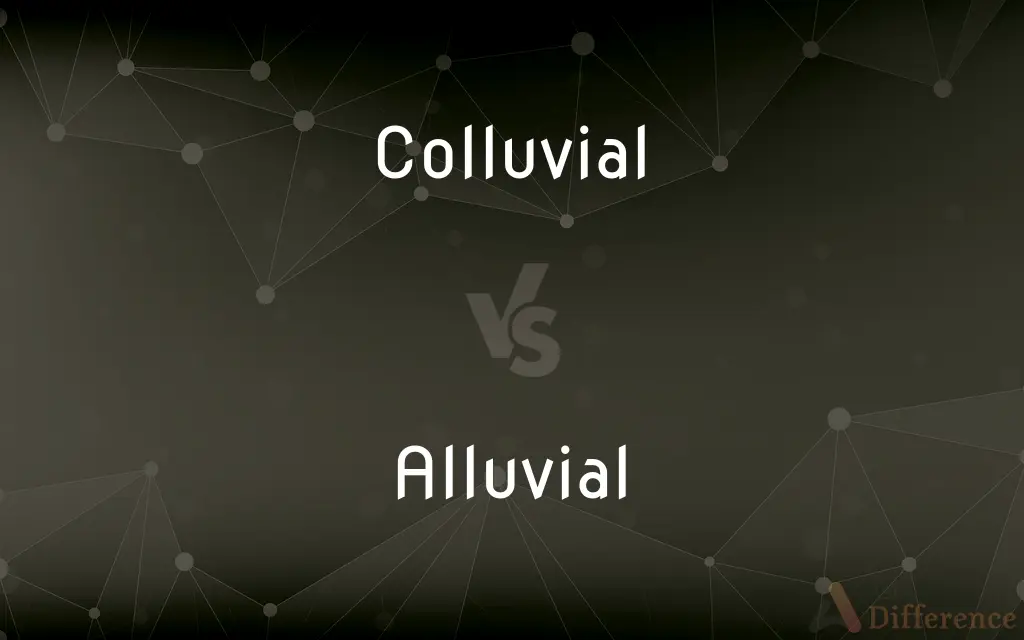Colluvial vs. Alluvial — What's the Difference?
By Tayyaba Rehman & Maham Liaqat — Updated on April 22, 2024
Colluvial deposits are formed through gravity-driven processes near slopes, while alluvial deposits result from water transport in riverbeds and floodplains.

Difference Between Colluvial and Alluvial
Table of Contents
ADVERTISEMENT
Key Differences
Colluvial materials accumulate due to the gravitational movement of debris down slopes, primarily influenced by gravity and minimal water action. Whereas alluvial materials are deposited by flowing water, particularly in rivers and streams, which actively sorts the particles by size.
Colluvial deposits are typically unsorted, with a chaotic mixture of various-sized particles ranging from clays to boulders. On the other hand, alluvial deposits are more sorted and stratified, often characterized by finer sediments like silt and sand, especially in lower energy environments like floodplains.
The source of colluvial materials is usually the immediate surrounding area, making them more localized. Conversely, alluvial materials can be sourced from regions far upstream, carried by rivers and deposited over a wide area as the water's energy decreases.
Colluvial deposits are often found at the base of slopes or along hillside crests, reflecting their origin from mass wasting and hillside erosion. In contrast, alluvial deposits are typically found in river channels, deltas, and floodplains where water flow plays a significant role in their deposition and distribution.
Colluvial environments are generally more stable and less dynamic than alluvial environments, which are constantly reshaped by the hydrodynamic forces of moving water. This results in different ecological and soil characteristics between the two deposit types.
ADVERTISEMENT
Comparison Chart
Formation Process
Gravity-driven sediment movement
Water transport and deposition
Particle Sorting
Poorly sorted, mixed sizes
Well sorted, size differentiation
Typical Location
Base of slopes, hillside crests
Riverbeds, floodplains, deltas
Material Source
Localized from immediate area
Can originate far upstream
Environmental Impact
Stable, less dynamic environments
Dynamic, frequently changing
Compare with Definitions
Colluvial
Deposits formed by the accumulation of rock fragments.
Colluvial layers in mountainous areas can tell much about past geological instability.
Alluvial
Pertaining to sediment deposited by flowing water.
The fertile alluvial soil of the river delta supports extensive agriculture.
Colluvial
Characterized by a lack of sorting and stratification.
Unlike river sediments, the colluvial material was jumbled and unsorted.
Alluvial
Characterized by well-sorted layers, often sand or gravel.
The alluvial gravel beds were ideal for constructing natural filtration systems.
Colluvial
Relating to material accumulated at the base of a slope due to gravity.
The geologist identified the debris as colluvial, typical of sediment that had merely fallen rather than been washed in.
Alluvial
Formed in areas with abundant water movement and deposition.
Alluvial plains are crucial for absorbing seasonal floodwaters.
Colluvial
Pertaining to sediments deposited primarily through mass wasting.
The thick colluvial deposit was evidence of numerous landslides over centuries.
Alluvial
Associated with dynamic and changing environments.
Alluvial islands in the river are continually reshaped by the current.
Colluvial
Typically found at the foot of a cliff or steep slopes.
Colluvial fans often form where large amounts of sediment are dropped at slope bases.
Alluvial
Relating to deposits in river beds and floodplains.
Alluvial gold mining depends on fine particles in river sands.
Colluvial
A loose deposit of rock debris accumulated through the action of gravity at the base of a cliff or slope.
Alluvial
Relating to or derived from alluvium
Rich alluvial soils
Colluvial
Of or pertaining to colluvium
Alluvial
Of, relating to, or found in alluvium
Alluvial soil.
Alluvial gold.
Alluvial
Pertaining to the soil deposited by a stream.
Alluvial
(countable) A deposition of sediment over a long period of time by a river; an alluvial layer.
Alluvial
Alluvial soil; specifically, in Australia, gold-bearing alluvial soil.
Alluvial
Alluvial soil; specif., in Australia, gold-bearing alluvial soil.
Alluvial
Pertaining to, contained in, or composed of, alluvium; relating to the deposits made by flowing water; washed away from one place and deposited in another; as, alluvial soil, mud, accumulations, deposits.
Alluvial
Of or relating to alluvium
Common Curiosities
Can colluvial deposits be found away from mountainous areas?
Yes, they can occur anywhere with sufficient slope for gravity to move debris, though they are more common in hilly or mountainous terrains.
Where are colluvial deposits typically found?
They are often located at the base of slopes or near cliffs where gravity pulls debris downward.
What are the characteristics of alluvial deposits?
Alluvial deposits are usually well-sorted, with distinct layers and are formed in water-rich environments.
How do the sources of material differ in colluvial and alluvial deposits?
Colluvial materials come from the immediate area due to gravity, while alluvial materials can be transported from far upstream by rivers.
What distinguishes colluvial deposits from alluvial deposits?
Colluvial deposits are primarily formed by gravity without water transport, whereas alluvial deposits result from water action.
What are the ecological impacts of colluvial and alluvial deposits?
Colluvial areas tend to be more stable, supporting different plant and animal life compared to the more dynamic alluvial environments.
How does climate change affect colluvial and alluvial deposits?
Changes in weather patterns can increase erosion and sediment transport, altering these deposits significantly.
How does the texture of colluvial and alluvial materials compare?
Colluvial materials are coarser and less sorted, while alluvial materials are finer and well-layered.
What role do colluvial and alluvial deposits play in natural disaster mitigation?
These deposits can help buffer against natural disasters like floods by absorbing excess water or stabilizing slopes.
Why are alluvial deposits significant for agriculture?
They often contain fertile soils and good moisture retention characteristics, making them ideal for farming.
What safety concerns are associated with colluvial areas?
Areas with colluvial deposits can be prone to landslides, especially after heavy rainfall.
What tools are used to study colluvial and alluvial deposits?
Geologists use tools like sediment cores, soil grids, and flow meters to study these deposits.
What is the impact of human activity on colluvial and alluvial deposits?
Human activities, such as construction and agriculture, can disrupt these deposits, affecting erosion and sedimentation patterns.
Can colluvial and alluvial materials be used in construction?
Yes, both types of materials are used in construction, particularly for fill, foundation material, and landscape design, though their suitability varies based on their properties.
Are there specific conservation practices for managing alluvial plains?
Yes, practices include maintaining vegetation strips to stabilize soil and managing water flow to prevent erosion.
Share Your Discovery

Previous Comparison
Conflate vs. Confound
Next Comparison
Spirogram vs. SpirometryAuthor Spotlight
Written by
Tayyaba RehmanTayyaba Rehman is a distinguished writer, currently serving as a primary contributor to askdifference.com. As a researcher in semantics and etymology, Tayyaba's passion for the complexity of languages and their distinctions has found a perfect home on the platform. Tayyaba delves into the intricacies of language, distinguishing between commonly confused words and phrases, thereby providing clarity for readers worldwide.
Co-written by
Maham Liaqat












































